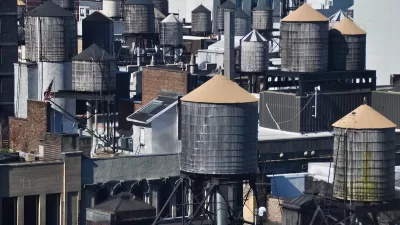The entire state is drought-free for the first time in years.

The U.S. Drought Monitor reveals a—mostly—drought-free California for the first time since early 2020, reports Iman Palm for KTLA, with no parts of the state in the “extreme or exceptional” drought category.
According to Palm, “Siskiyou, Modoc and Del Norte counties in Northern California are still classified as “abnormally dry,” the U.S. Drought Monitor’s least severe classification. Small portions of Riverside, San Bernardino and Imperial counties have the same classification.”
Almost one year ago, almost all of the state’s Central Valley was in an “exceptional” drought, prompting stricter conservation measures. “The last time California was drought-free was from March to September 2019, before experiencing a moderate drought. The state was declared drought-free again from November 2019 until February 2020, data from the U.S. Drought Monitor shows.”
FULL STORY: California has been declared drought-free for the first time in years

Alabama: Trump Terminates Settlements for Black Communities Harmed By Raw Sewage
Trump deemed the landmark civil rights agreement “illegal DEI and environmental justice policy.”

Planetizen Federal Action Tracker
A weekly monitor of how Trump’s orders and actions are impacting planners and planning in America.

Why Should We Subsidize Public Transportation?
Many public transit agencies face financial stress due to rising costs, declining fare revenue, and declining subsidies. Transit advocates must provide a strong business case for increasing public transit funding.

Judge Orders Release of Frozen IRA, IIJA Funding
The decision is a victory for environmental groups who charged that freezing funds for critical infrastructure and disaster response programs caused “real and irreparable harm” to communities.

‘Clybourne Park’ Sets Stage for Housing Equity Discussions
Clybourne Park, a play exploring race, real estate, and community tensions, can set the stage for discussion on the lasting impacts of housing discrimination, gentrification, and the fight for affordability.

Understanding Road Diets
An explainer from Momentum highlights the advantages of reducing vehicle lanes in favor of more bike, transit, and pedestrian infrastructure.
Urban Design for Planners 1: Software Tools
This six-course series explores essential urban design concepts using open source software and equips planners with the tools they need to participate fully in the urban design process.
Planning for Universal Design
Learn the tools for implementing Universal Design in planning regulations.
Caltrans
Smith Gee Studio
Institute for Housing and Urban Development Studies (IHS)
City of Grandview
Harvard GSD Executive Education
Toledo-Lucas County Plan Commissions
Salt Lake City
NYU Wagner Graduate School of Public Service





























